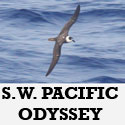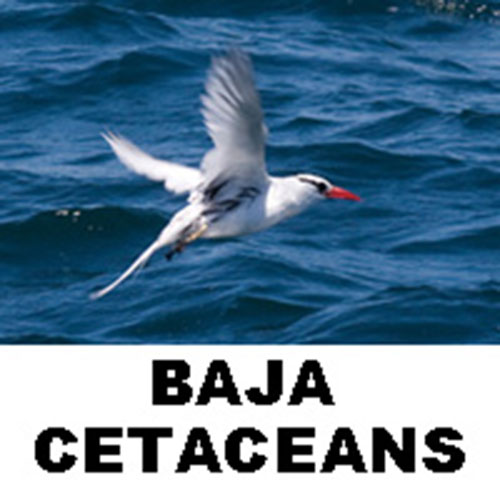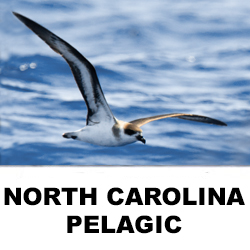 The Atlantic Odyssey was born as a repositioning trip for ships which, having spent the Austral summer visiting
Antarctica, were sailing north to do the same in Arctic regions. Wildwings in particular realised the potential
for seabirding, and along with the cruise operators developed a 30 day cruise which now visits the
Antarctic Peninsular and most of the island groups in the South Atlantic. A similar trip is still available, but in a
much larger vessel, which is not so enjoyable in our opinion, but the smaller ships have been largely retired.
The Atlantic Odyssey was born as a repositioning trip for ships which, having spent the Austral summer visiting
Antarctica, were sailing north to do the same in Arctic regions. Wildwings in particular realised the potential
for seabirding, and along with the cruise operators developed a 30 day cruise which now visits the
Antarctic Peninsular and most of the island groups in the South Atlantic. A similar trip is still available, but in a
much larger vessel, which is not so enjoyable in our opinion, but the smaller ships have been largely retired.
Our ship sailed from Ushuaia, on Tierra del Fuego, the main port for trips to the Peninsular; Wildwings offered
a local birding tour on the day before (most people arrive a day early to allow for delays). Most of the
region's specialities are usually seen on this tour, including Magellanic Woodpecker, Spectacled Duck, White-throated
Caracara and Andean Condor. In addition we saw Chilean Hawk (a rare Accipiter, split from
Bicolored Hawk), and went out in
the evening with a local guide to be shown Rufous-legged Owl. In the course of the evening we also had very
close views of Magellanic Owl, bringing our Owl total to three (Austral Pygmy Owl during the day).
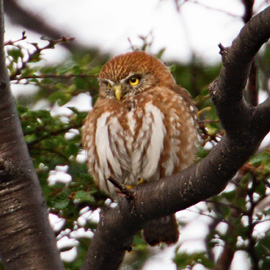 The next morning, before the ship left harbour we also visited the local abbatoir which gave us superb close-up views of adult
White-throated Caracara, Flightless Steamer Duck,Dolphin Gull and Chilean Skuas
among others. Of course, we were back late, this meant a quick dash round the supermarket for supplies for our cabin in case we couldn't leave
it due to bad weather. The hurried purchases resulted in my buying a large bottle of what I thought was pineapple juice, only to realise
on opening that it was bleach! As the ship departed
for the Southern Oceans and sailed along the Beagle Channel we began to see Albatrosses, Diving Petrels etc.,
which would be much in evidence later; and Magellanic Penguins, which wouldn't. The following morning saw us well
into the Drake Passage, which is usually rough or very rough. On this occasion it wasn't too bad, and it is unusual
to have bad seas on both crossings all the time. Having said that, if you have to retire to your bunk most species will
be seen again later, but the conditions are usually windswept enough to keep plenty of birds in the air and provide a superb spectacle.
Albatrosses in particular often approach the ship very closely in their constant search for food, also this type of vessel is small enough that other
species will not be too wary, as may be the case with a larger cruise ship.
The next morning, before the ship left harbour we also visited the local abbatoir which gave us superb close-up views of adult
White-throated Caracara, Flightless Steamer Duck,Dolphin Gull and Chilean Skuas
among others. Of course, we were back late, this meant a quick dash round the supermarket for supplies for our cabin in case we couldn't leave
it due to bad weather. The hurried purchases resulted in my buying a large bottle of what I thought was pineapple juice, only to realise
on opening that it was bleach! As the ship departed
for the Southern Oceans and sailed along the Beagle Channel we began to see Albatrosses, Diving Petrels etc.,
which would be much in evidence later; and Magellanic Penguins, which wouldn't. The following morning saw us well
into the Drake Passage, which is usually rough or very rough. On this occasion it wasn't too bad, and it is unusual
to have bad seas on both crossings all the time. Having said that, if you have to retire to your bunk most species will
be seen again later, but the conditions are usually windswept enough to keep plenty of birds in the air and provide a superb spectacle.
Albatrosses in particular often approach the ship very closely in their constant search for food, also this type of vessel is small enough that other
species will not be too wary, as may be the case with a larger cruise ship.
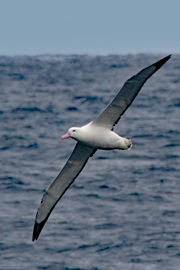 The Drake Passage, the area of the Southern Ocean between South America and the Antarctic Peninsular, is THE place for
Albatrosses and Petrels. We saw four species of Albatross including Grey-headed. It is possible to see more including
the superb Light-mantled Sooty, but it's nice to spread things out a bit. Petrels included Southern Giant and
Hall's (Northern)
Giant, White-chinned, Pintado, Soft-plumaged and several Diving-petrels. These last are often unidentifable but Magellanic
and Common are the most likely. As the ship sailed south, Prions and Blue Petrels became evident, along with
Wilson's and
Black-bellied Storm-petrels. Prions are very difficult to identify at sea but they approach ships closely and often follow in
the wake, so excellent views are possible allowing positive identification in many cases. Alternatively with digital
camera equipment enough frames can be taken to get a decent shot (usually about one in fifty) which enables a later decision.
The real bonus comes when you've seen and identified all the species, and you can just enjoy their wonderful exuberant
flight actions! Antarctic Prions are the common species in the passage. The voyage down to the first landing area,in our case
Aitcho Island in the South Shetlands, usually takes up to two days, the seabirds get better all the time, and whales often
begin to appear as the vessel proceeds south. The actual routes and landings vary from one ship operator to another, and
are also dependent on conditions, but roughly the same species will be seen (with one important exception) on any voyage. The
Odyssey doesn't spend as long around the Antarctic Peninsular as some trips, as obviously there is a lot more to do later.
The Drake Passage, the area of the Southern Ocean between South America and the Antarctic Peninsular, is THE place for
Albatrosses and Petrels. We saw four species of Albatross including Grey-headed. It is possible to see more including
the superb Light-mantled Sooty, but it's nice to spread things out a bit. Petrels included Southern Giant and
Hall's (Northern)
Giant, White-chinned, Pintado, Soft-plumaged and several Diving-petrels. These last are often unidentifable but Magellanic
and Common are the most likely. As the ship sailed south, Prions and Blue Petrels became evident, along with
Wilson's and
Black-bellied Storm-petrels. Prions are very difficult to identify at sea but they approach ships closely and often follow in
the wake, so excellent views are possible allowing positive identification in many cases. Alternatively with digital
camera equipment enough frames can be taken to get a decent shot (usually about one in fifty) which enables a later decision.
The real bonus comes when you've seen and identified all the species, and you can just enjoy their wonderful exuberant
flight actions! Antarctic Prions are the common species in the passage. The voyage down to the first landing area,in our case
Aitcho Island in the South Shetlands, usually takes up to two days, the seabirds get better all the time, and whales often
begin to appear as the vessel proceeds south. The actual routes and landings vary from one ship operator to another, and
are also dependent on conditions, but roughly the same species will be seen (with one important exception) on any voyage. The
Odyssey doesn't spend as long around the Antarctic Peninsular as some trips, as obviously there is a lot more to do later.
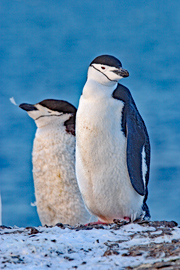 The other factor if visiting Antarctica is the timing, as we had been before it was less important to us. At the time of the Odyssey
many of the penguin colonies are all but deserted, and dirty after the breeding season. A number of dead chicks are usually
in evidence also, but generally speaking there are sufficient birds still around for excellent viewing and photographic
opportunities. We saw plenty of Adelie, Gentoo and Chinstrap Penguins, plus Sheathbills, South Polar
and Brown Skuas, and
Antarctic Shags and Terns. Some of the penguins were in moult at this time and looking rather scruffy.
The other factor if visiting Antarctica is the timing, as we had been before it was less important to us. At the time of the Odyssey
many of the penguin colonies are all but deserted, and dirty after the breeding season. A number of dead chicks are usually
in evidence also, but generally speaking there are sufficient birds still around for excellent viewing and photographic
opportunities. We saw plenty of Adelie, Gentoo and Chinstrap Penguins, plus Sheathbills, South Polar
and Brown Skuas, and
Antarctic Shags and Terns. Some of the penguins were in moult at this time and looking rather scruffy.
In all we made five landings in the Peninsular area over the course of the next two days, having sailed overnight from Aitcho Island.
Mammals are also much in evidence, we saw all the expected seals (Weddell, Crabeater, and Antarctic Fur) plus Elephant
and Leopard (seals, silly!) This last cannot be relied on although one or two are usually seen, often on ice floes, and Elephant Seals
are much commoner further north. Cetaceans vary from one trip to the next, we had a wonderful hour or more watching a pack
of Orcas hunting Antarctic Minke Whales, often very close to the ship.
Of course, two birds I haven't mentioned will be high on most birder's wish list- Antarctic and Snow Petrels. The fact is that
neither are guaranteed, although Snows are usually seen, indeed we saw several during our journeys between islands. This is in
fact one of the advantages of the timing of the Odyssey, since large numbers of both species are usually present in the Weddell
Sea at this time.
As we turned northwards again we spent an evening in ice floes, icebergs and brash ice, and everyone was looking for one bird
which is very rarely seen on normal Antarctic trips- Emperor Penguin. However, partly due to the time and also the route (many
trips return on a more westerly bearing), the Odyssey has turned up trumps over the last few years. Our trip was no exception
and we had close views of a bird (albeit juvenile) standing on an ice-floe and eventually swimming away. My last penguin!, and
one of my target species for the trip. They're not guaranteed, one year eight were seen, the year after we travelled none, and back
to three in 2007.
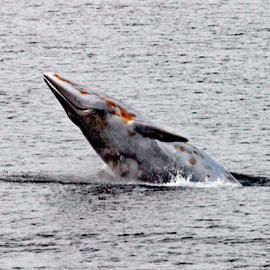 Most people having slept well for various reasons, the next day was spent crossing somewhat more open water to the South Orkney Islands.
We awoke to large flocks of Antarctic (Southern) Fulmars around the ship. Other birds included Snow Petrels, Wilson's and
Black-bellied Storm-petrels, Antarctic Terns, and Chinstrap and Adelie Penguins sitting on ice floes. The "bird of the day" was seen
in numbers (50+), this being the sought-after Antarctic Petrel. They were often seen sat on the top of tabular icebergs, frequently
with Snow Petrels. As I said earlier this species is not guaranteed, we had seen none previously on this trip, but this area
late in the season is probably the most reliable region. Cetaceans also abound here, we saw 27 Humpback, 8 Fin, 11 Orcas, 4
Antarctic Minkes and 3 Southern Bottlenose Whales on this day. (total for the ship).
Most people having slept well for various reasons, the next day was spent crossing somewhat more open water to the South Orkney Islands.
We awoke to large flocks of Antarctic (Southern) Fulmars around the ship. Other birds included Snow Petrels, Wilson's and
Black-bellied Storm-petrels, Antarctic Terns, and Chinstrap and Adelie Penguins sitting on ice floes. The "bird of the day" was seen
in numbers (50+), this being the sought-after Antarctic Petrel. They were often seen sat on the top of tabular icebergs, frequently
with Snow Petrels. As I said earlier this species is not guaranteed, we had seen none previously on this trip, but this area
late in the season is probably the most reliable region. Cetaceans also abound here, we saw 27 Humpback, 8 Fin, 11 Orcas, 4
Antarctic Minkes and 3 Southern Bottlenose Whales on this day. (total for the ship).
Almost an anti-climax, the following day saw us first visiting the Argentine base of Orcadas, and then setting sail for the
South Georgia group. Most of the afternoon was taken up weaving our way through the islands of the South Orkney group, where
thousands of Chinstraps were seen, also more Minkes and two Southern Right Whales right alongside just before we
reached open water. As we continued Albatrosses began to reappear in numbers, including our first Light-mantled Sooty, also several
more cetaceans although nothing new. There was a new bird for the trip, a Kerguelen Petrel, which I managed to miss.
 The following day was spent at sea, with no new species of bird but plenty in evidence including Light-mantled Sooty,
Wandering and Grey-headed Albatrosses and more Kerguelen Petrels. The avian highlight was a passage of some 6000 Antarctic
Prions and 2000 Blue Petrels but for some this amazing sight was eclipsed by a real cetacean rarity.
A Strap-toothed Whale breached some
six or seven times so close to the vessel that I couldn't get it all in with a 200mm lens! Other cetaceans (getting blase now)
included Cuvier's Beaked and Southern Bottlenose Whales, and Hourglass Dolphins. As we drew closer to South Georgia Macaroni
and King Penguins began to appear in the water. It is always worth having a good look at penguins in the water as landings
can never be relied on to happen due to weather and sea conditions, indeed this was to be the case in South Georgia. Three landing
sites could not be accessed due to heavy surf and we never really got close to any penguin colonies, although plenty of Kings
were around where we did land and Macaronis were approached closely on a Zodiac cruise. Other factors affect landing sites,
for instance, Albatross Island, where we had landed ten years previously, is now out of bounds.
The following day was spent at sea, with no new species of bird but plenty in evidence including Light-mantled Sooty,
Wandering and Grey-headed Albatrosses and more Kerguelen Petrels. The avian highlight was a passage of some 6000 Antarctic
Prions and 2000 Blue Petrels but for some this amazing sight was eclipsed by a real cetacean rarity.
A Strap-toothed Whale breached some
six or seven times so close to the vessel that I couldn't get it all in with a 200mm lens! Other cetaceans (getting blase now)
included Cuvier's Beaked and Southern Bottlenose Whales, and Hourglass Dolphins. As we drew closer to South Georgia Macaroni
and King Penguins began to appear in the water. It is always worth having a good look at penguins in the water as landings
can never be relied on to happen due to weather and sea conditions, indeed this was to be the case in South Georgia. Three landing
sites could not be accessed due to heavy surf and we never really got close to any penguin colonies, although plenty of Kings
were around where we did land and Macaronis were approached closely on a Zodiac cruise. Other factors affect landing sites,
for instance, Albatross Island, where we had landed ten years previously, is now out of bounds.
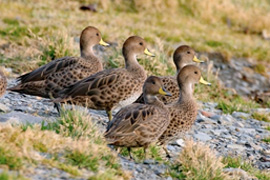 South Georgia, which covers a large area and many islands, is scenically superb and steeped in history (from Shackleton to the
Falklands/Malvinas conflict), but this is a report from a purely wildlife viewpoint. I just don't want anyone to think that
there is no other interest on this voyage, there is plenty and the comment applies to all the other islands visited.
During our three days in the area we made three landings including Grytviken Harbour where passports are stamped. All ships
have to report there before landing elsewhere, but it usually has South Georgia Pintail
and South Georgia Shag around as well as other bird species and
seals. The only bird potentially a problem is South Georgia Pipit, as they now breed almost entirely on small offshore islands.
We saw a number on a Zodiac cruise which gave reasonably good views. The only other new species was an introduced mammal,
reindeer, but several bird species were notable for the sheer numbers, such as Light-mantled Sooty Albatross.
South Georgia, which covers a large area and many islands, is scenically superb and steeped in history (from Shackleton to the
Falklands/Malvinas conflict), but this is a report from a purely wildlife viewpoint. I just don't want anyone to think that
there is no other interest on this voyage, there is plenty and the comment applies to all the other islands visited.
During our three days in the area we made three landings including Grytviken Harbour where passports are stamped. All ships
have to report there before landing elsewhere, but it usually has South Georgia Pintail
and South Georgia Shag around as well as other bird species and
seals. The only bird potentially a problem is South Georgia Pipit, as they now breed almost entirely on small offshore islands.
We saw a number on a Zodiac cruise which gave reasonably good views. The only other new species was an introduced mammal,
reindeer, but several bird species were notable for the sheer numbers, such as Light-mantled Sooty Albatross.
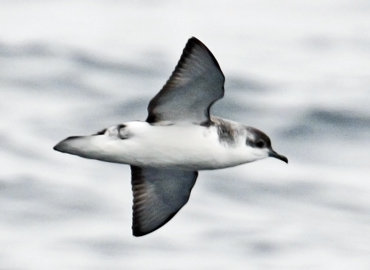 We now embarked on that section of our journey which few travellers experience, the Atlantic Ocean and its islands. From
South Georgia it is a four day sail to Gough, the next port of call, but the seabirds are fantastic. Our first day out became
increasingly rough, approaching gusts of force 10 eventually, but this only improves seabird sightings, and by the next morning the
seas were much calmer. As the ship sailed north new seabird species began to appear. The first day was noteworthy for large
numbers of Soft-plumaged and Kerguelen Petrels, and also Great Shearwaters, Grey Petrels and Sooty Albatrosses. These new species
were missed by many people who were inside due to the storm, but they were only a small taster of things to come.
We now embarked on that section of our journey which few travellers experience, the Atlantic Ocean and its islands. From
South Georgia it is a four day sail to Gough, the next port of call, but the seabirds are fantastic. Our first day out became
increasingly rough, approaching gusts of force 10 eventually, but this only improves seabird sightings, and by the next morning the
seas were much calmer. As the ship sailed north new seabird species began to appear. The first day was noteworthy for large
numbers of Soft-plumaged and Kerguelen Petrels, and also Great Shearwaters, Grey Petrels and Sooty Albatrosses. These new species
were missed by many people who were inside due to the storm, but they were only a small taster of things to come.
During the night many of us were woken by a wave which actually dented the steel plate of the bow, but these are tough
little ships and some of us were up early, in much calmer waters, to see a White-headed Petrel cross the bows. This is
really a vagrant to the Atlantic (New Zealand breeder) but many more birders saw a second about four hours later, and I saw
and photographed a third whilst alone at the side of the ship (I'd just been to my cabin for something) in the afternoon. Of
course all sightings could have been the same bird, but they do occur with reasonable frequency in the South Atlantic.
Our first fully identified Slender-billed Prion came later that day, although some of the birds near South Georgia were
almost certainly this species (I've photographed them there before). Great-winged Petrel, (Subantarctic) Little Shearwater and
White-bellied Storm-petrel all pointed to the fact that we were heading towards warmer waters. Cetaceans continued to be
in evidence, the highlight being four Southern Right Whale Dolphins close to the ship.
Less species were evident the following day, our ship being midway between breeding stations, but Atlantic Petrels
and Broad-billed Prions began to appear, also Grey-backed Storm-petrel
which, although circumpolar on Subantarctic islands, is always a bit
of a "hit-or-miss" species as they occur in relatively small numbers. Slender-billed and Fairy Prions were also seen.
Our last day before Gough saw numbers increasing again, over 1000 Broad-billed Prions, and the Tristan breeders Atlantic
Yellow-nosed Albatross and Spectacled Petrel put in an appearance.
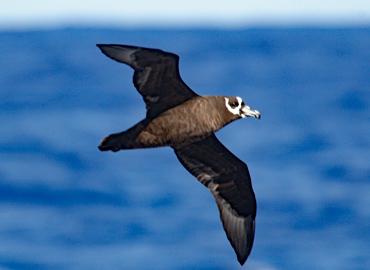
 Gough Island is quite simply one of the most important seabird breeding stations in the world. An estimate of 20 million pairs
of 12 species has been made, some of which breed only in the Tristan group. (Gough is considered part of that group, although
some 450km south of the other islands). During our approach we recorded some eighteen species of tubenose, although none was
new except White-faced Storm-petrel which had not been recorded at all on previous Odysseys, although they are recorded as
breeding on Gough. The fantastic thing is the huge numbers of birds, such as hundreds of Great and Subantarctic Little
Shearwaters, and dozens of Atlantic and Soft-plumaged Petrels. The whole island supports rich vegetation, with narrow
beaches giving way to steep cliffs and deep gullies, all covered in green. As a World Heritage site, landing is not allowed,
but on the sheltered side we were able to Zodiac cruise a matter of yards from the shore. Everywhere are Subantarctic Fur Seals,
probably the most attractive Fur Seal with a two-tone pelt which ranges from buff-brown to orange below. Noisy and aggresive,
their call is an eerie wail, which echoed around the cliffs and gave the impression of an island unchanged since prehistoric
times. The island has two endangered endemics, Gough Bunting and Gough Island Moorhen, both were seen from
the Zodiacs while cruising. The Bunting came down on the rocks of the shoreline, whilst the Moorhen proved a bit problematic, but eventually two
gave themselves up part way up one of the small valleys. Most trips manage to see both species.
Gough Island is quite simply one of the most important seabird breeding stations in the world. An estimate of 20 million pairs
of 12 species has been made, some of which breed only in the Tristan group. (Gough is considered part of that group, although
some 450km south of the other islands). During our approach we recorded some eighteen species of tubenose, although none was
new except White-faced Storm-petrel which had not been recorded at all on previous Odysseys, although they are recorded as
breeding on Gough. The fantastic thing is the huge numbers of birds, such as hundreds of Great and Subantarctic Little
Shearwaters, and dozens of Atlantic and Soft-plumaged Petrels. The whole island supports rich vegetation, with narrow
beaches giving way to steep cliffs and deep gullies, all covered in green. As a World Heritage site, landing is not allowed,
but on the sheltered side we were able to Zodiac cruise a matter of yards from the shore. Everywhere are Subantarctic Fur Seals,
probably the most attractive Fur Seal with a two-tone pelt which ranges from buff-brown to orange below. Noisy and aggresive,
their call is an eerie wail, which echoed around the cliffs and gave the impression of an island unchanged since prehistoric
times. The island has two endangered endemics, Gough Bunting and Gough Island Moorhen, both were seen from
the Zodiacs while cruising. The Bunting came down on the rocks of the shoreline, whilst the Moorhen proved a bit problematic, but eventually two
gave themselves up part way up one of the small valleys. Most trips manage to see both species.
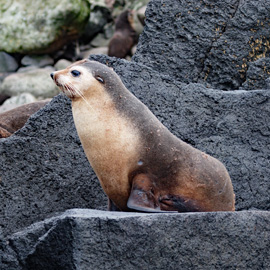
We sailed overnight from Gough, and the main island of Tristan da Cunha was visible when we woke in the morning.
Large numbers of birds remained the norm, many now following the ship, especially Spectacled Petrels. Others in the
air included Yellow-nosed, Sooty, and Tristan Albatrosses, seven species of petrel,
and White-bellied Storm-petrels. Nearer
the island Tristan Skuas appeared, they are largely responsible for numerous corpses of Broad-billed Prions which
litter Nightingale Island.
As well as the main island
there are two on which landings are attempted, Inaccesible and Nightingale. There is little birdlife on the main island, but
a landing is made to meet with the islanders, who provide guides for the other islands, and gain an appreciation of life in one
of the remotest colonies in the world. Unfortunately, from a birders viewpoint, the weather is king, and landings are often
impossible. To date, only one trip has managed to see all four endemics, these being Inaccesible Island Rail (which we missed),
Tristan Thrush, Tristan Bunting, and Grosbeak (Wilkins) Bunting. The latter three can all be found on Nightingale, along with
a colony of Northern Rockhopper Penguins (a recently proposed split).
 In our case no landings at all were possible on the day of our arrival, so we cruised to Inaccessible where there are numerous
breeding seabirds, and did some chumming. As would be expected Great Shearwaters were in abundance, as over 90% of the world's
population breeds on the island, but large numbers of Soft-plumaged and Great-winged Petrels, and Tristan, Yellow-nosed and
Sooty Albatrosses, and Southern Giant Petrels, among others. That evening we stayed in the sheltered bay where we'd been
chumming to have dinner, but unfortunately a heavy rainstorm hit, and the ship's lights were on. This resulted in over fifty
disorientated seabirds all over the decks. Ann and I and a couple of the leaders went out to rescue them, and I am happy to
say not one bird died. Many had made their way to odd corners difficult to access, and I well remember being suspended between
two wheelie bins on the rear deck, held by Tony Marr (Wildwings leader) and Ann, whilst I extricated a Diving-petrel! Other species involved included
Great Shearwaters, Soft-plumaged Petrels and White-bellied Storm-petrels. Very few birds struggled, they seemed to know we
were trying to help them, although some regurgitated. After about half a minute we were completely soaked, so that ceased to
bother us, and the experience was very satisfying, and humbling. Needless to say the ships lights were soon dimmed, and soon after
the skies cleared, so the danger passed.
In our case no landings at all were possible on the day of our arrival, so we cruised to Inaccessible where there are numerous
breeding seabirds, and did some chumming. As would be expected Great Shearwaters were in abundance, as over 90% of the world's
population breeds on the island, but large numbers of Soft-plumaged and Great-winged Petrels, and Tristan, Yellow-nosed and
Sooty Albatrosses, and Southern Giant Petrels, among others. That evening we stayed in the sheltered bay where we'd been
chumming to have dinner, but unfortunately a heavy rainstorm hit, and the ship's lights were on. This resulted in over fifty
disorientated seabirds all over the decks. Ann and I and a couple of the leaders went out to rescue them, and I am happy to
say not one bird died. Many had made their way to odd corners difficult to access, and I well remember being suspended between
two wheelie bins on the rear deck, held by Tony Marr (Wildwings leader) and Ann, whilst I extricated a Diving-petrel! Other species involved included
Great Shearwaters, Soft-plumaged Petrels and White-bellied Storm-petrels. Very few birds struggled, they seemed to know we
were trying to help them, although some regurgitated. After about half a minute we were completely soaked, so that ceased to
bother us, and the experience was very satisfying, and humbling. Needless to say the ships lights were soon dimmed, and soon after
the skies cleared, so the danger passed.
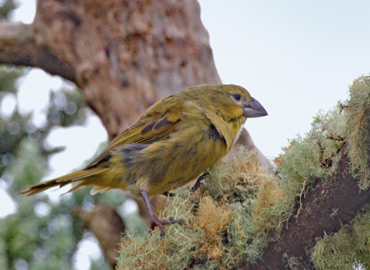 In fact the only landing we managed which was wildlife orientated was to Nightingale Island. An attempt was made for the Inaccesible Rail
but the sea conditions put paid to that. On landing on Nightingale we did not have time to both visit the penguin colony and see the Grosbeak
Bunting, since the latter only occurs on the plateau in a small area of stunted trees. However penguins were seen in the water, so most birders opted
for the walk to the top. The initial stages of the ascent were quite interesting as the path from the landing stage is very steep, involving the use of ropes
in parts. However, everyone made it to the fork where down and left went to the penguin colony, and up and right to a very rare bunting.
The hike up to the bunting plateau, however, is fantastic, as the path is lined with Yellow-nosed Albatrosses on nests and
Great Shearwaters continually coming out of the vegetation and using the path as a launch pad. It is not a case of not approaching
the birds too closely, more picking your way between their bills and ducking the birds taking off! The Albatrosses are usually
juvenile/immature birds, we did see one adult but this was unprecedented according to Tony Marr. Most
birds seen in flight around the islands (and there were many) are adults though. Tristan Thrushes and Buntings are frequently seen
along the path, also birds which are apparently hybrid Grosbeak/Tristan Buntings. When you see a pure Grosbeak Bunting you will
know, as the bill actually puts its namesake to shame! Unfortunately, pure birds are few in number, much habitat has been
lost due to storms, and not every trip scores.
In fact the only landing we managed which was wildlife orientated was to Nightingale Island. An attempt was made for the Inaccesible Rail
but the sea conditions put paid to that. On landing on Nightingale we did not have time to both visit the penguin colony and see the Grosbeak
Bunting, since the latter only occurs on the plateau in a small area of stunted trees. However penguins were seen in the water, so most birders opted
for the walk to the top. The initial stages of the ascent were quite interesting as the path from the landing stage is very steep, involving the use of ropes
in parts. However, everyone made it to the fork where down and left went to the penguin colony, and up and right to a very rare bunting.
The hike up to the bunting plateau, however, is fantastic, as the path is lined with Yellow-nosed Albatrosses on nests and
Great Shearwaters continually coming out of the vegetation and using the path as a launch pad. It is not a case of not approaching
the birds too closely, more picking your way between their bills and ducking the birds taking off! The Albatrosses are usually
juvenile/immature birds, we did see one adult but this was unprecedented according to Tony Marr. Most
birds seen in flight around the islands (and there were many) are adults though. Tristan Thrushes and Buntings are frequently seen
along the path, also birds which are apparently hybrid Grosbeak/Tristan Buntings. When you see a pure Grosbeak Bunting you will
know, as the bill actually puts its namesake to shame! Unfortunately, pure birds are few in number, much habitat has been
lost due to storms, and not every trip scores.
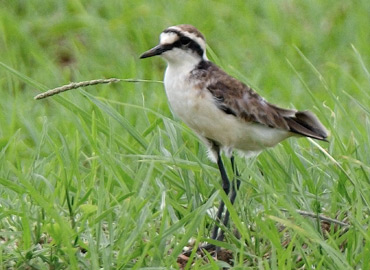 On leaving the Tristan group it is a long haul to the next island, St.Helena (15 degrees S). The voyage took over four days, and as it progressed the
weather gradually got warmer, the seas calmer, and unfortunately the birds fewer, in both variety and numbers. At first many Spectacled
Petrels and a few Albatrosses followed the ship, but this dwindled to just three Spectacled Petrels after a while, and hopes for a first record
for the Northern Hemisphere were finally dashed on the day we reached our next destination.
We did however record a few new species for the trip in the shape of Bulwer's Petrel,which continued to be seen
sporadically until just before the Cape Verde Islands,and Band-rumped Storm-petrel, also the first of many.
A most unexpected record on the first day out was an immature White-capped (Shy) Albatross which investigated the ship from
a distance over an hour or so, dropping back out of sight and then catching up. Although these birds disperse from their New
Zealand/Australian breeding grounds on a circumpolar route, rarely do they reach this far North in the Atlantic.
Just before reaching St.Helena we recorded Masked Booby and Red-billed Tropicbird, both of which breed
on the island. Well known as the island where Napoleon was exiled, the ship anchored off for a further two days,
and a ferry service was set up using the Zodiacs. Of course
the birders first port of call was Deadwood Plain, where the critically endangered Saint Helena Plover breeds. A number of birds were seen, both
adult and juvenile, which was a good sign, although habitat loss is the main threat to the species, along with predation from introduced species.
There are no other naturally occuring landbirds on the island, although eleven introduced species are present, a strange mixture which includes
Madagascar Fody, Yellow Canary and Java Sparrow, the last nesting on the dockside!
On leaving the Tristan group it is a long haul to the next island, St.Helena (15 degrees S). The voyage took over four days, and as it progressed the
weather gradually got warmer, the seas calmer, and unfortunately the birds fewer, in both variety and numbers. At first many Spectacled
Petrels and a few Albatrosses followed the ship, but this dwindled to just three Spectacled Petrels after a while, and hopes for a first record
for the Northern Hemisphere were finally dashed on the day we reached our next destination.
We did however record a few new species for the trip in the shape of Bulwer's Petrel,which continued to be seen
sporadically until just before the Cape Verde Islands,and Band-rumped Storm-petrel, also the first of many.
A most unexpected record on the first day out was an immature White-capped (Shy) Albatross which investigated the ship from
a distance over an hour or so, dropping back out of sight and then catching up. Although these birds disperse from their New
Zealand/Australian breeding grounds on a circumpolar route, rarely do they reach this far North in the Atlantic.
Just before reaching St.Helena we recorded Masked Booby and Red-billed Tropicbird, both of which breed
on the island. Well known as the island where Napoleon was exiled, the ship anchored off for a further two days,
and a ferry service was set up using the Zodiacs. Of course
the birders first port of call was Deadwood Plain, where the critically endangered Saint Helena Plover breeds. A number of birds were seen, both
adult and juvenile, which was a good sign, although habitat loss is the main threat to the species, along with predation from introduced species.
There are no other naturally occuring landbirds on the island, although eleven introduced species are present, a strange mixture which includes
Madagascar Fody, Yellow Canary and Java Sparrow, the last nesting on the dockside!
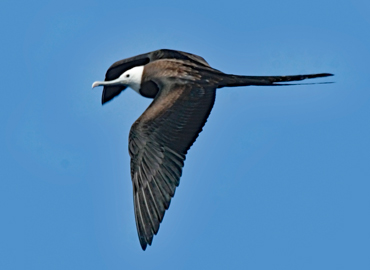 White Terns nest in the main town, Jamestown, but we saw
few other seabirds whilst ashore, most time was spent on historical sites, and in hotels/restaurants!. A boat trip was arranged locally to Speery
Island, an offshore stack, this was good for both birds and good views of (mainly) Pantropical Spotted Dolphins. Birds included close views
of Band-rumped Storm-petrels, this being one of the few storm-petrel species to attend colonies in daylight. Plenty of Black and
Brown Noddies were on the
cliffs of the main island, and at the stack itself Red-billed Tropicbirds were circling, and small numbers of
Sooty Terns were in evidence.
A Brown Booby was also seen, as were Arctic and Long-tailed Skuas at varying times, from the ship.
White Terns nest in the main town, Jamestown, but we saw
few other seabirds whilst ashore, most time was spent on historical sites, and in hotels/restaurants!. A boat trip was arranged locally to Speery
Island, an offshore stack, this was good for both birds and good views of (mainly) Pantropical Spotted Dolphins. Birds included close views
of Band-rumped Storm-petrels, this being one of the few storm-petrel species to attend colonies in daylight. Plenty of Black and
Brown Noddies were on the
cliffs of the main island, and at the stack itself Red-billed Tropicbirds were circling, and small numbers of
Sooty Terns were in evidence.
A Brown Booby was also seen, as were Arctic and Long-tailed Skuas at varying times, from the ship.
Being in the Tropics, the journey to Ascension Island was not enlivened by many birds at all, a few species were seen but
mainly distantly (tropicbirds and Sooty terns), and increasing numbers of birders took to "dude" pursuits such as
sunbathing, and tea and biscuits in the afternoon. No complaints, the flying fish helped keep the interest up and eventually
a few more birds began to appear and our destination was reached. Ascension itself is almost ruined, due to its
geographical location the island is given over to radar stations and telemetry operations, along with an RAF base. This base provides transport for
most people to return to the UK, but the service is subject to delays and overbooking. (We decided to stay on the ship for a further week, and
disembark in the Cape Verde Islands). However, work is being done to encourage seabirds to return to the main island, with some early success,
and an area near the airport provides a nest site for 1.5 million Sooty Terns. Unfortunately they breed on a fifteen month cycle, so are not present
for every voyage, thus it was the year we went.
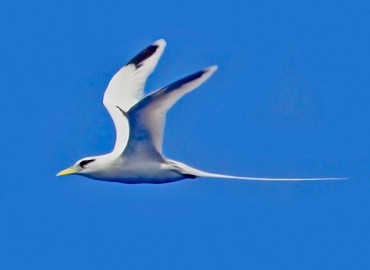 There is a lot of conservation work involving Atlantic Green Turtles which breed on the beaches, and we were taken to see females landing and egg-laying.
There is also the opportunity to get up early and watch hatchlings heading for the sea. However, the highlight from a birder's point of view is Bosunbird
Island. This is another large stack, less than half a mile offshore, on the opposite side of the main island, so the ship sailed along the coastline and
around the stack. It is the only known breeding station for Ascension Frigatebird, hence its name, as Bosunbird is an old sailor's name for Frigates.
Although the frigatebird is now officially on the British List, they do not seem to disperse far usually, and the remoteness of Ascension makes them
a very difficult bird to see otherwise. No problem here, the sky was full of them.
Plenty of other seabirds were in evidence too, warm water species now. These included Brown and Masked Boobies,
and Red-billed and White-tailed Tropicbirds, the last new for the trip. A few saw Red-footed Booby, but they are rare here.
There is a lot of conservation work involving Atlantic Green Turtles which breed on the beaches, and we were taken to see females landing and egg-laying.
There is also the opportunity to get up early and watch hatchlings heading for the sea. However, the highlight from a birder's point of view is Bosunbird
Island. This is another large stack, less than half a mile offshore, on the opposite side of the main island, so the ship sailed along the coastline and
around the stack. It is the only known breeding station for Ascension Frigatebird, hence its name, as Bosunbird is an old sailor's name for Frigates.
Although the frigatebird is now officially on the British List, they do not seem to disperse far usually, and the remoteness of Ascension makes them
a very difficult bird to see otherwise. No problem here, the sky was full of them.
Plenty of other seabirds were in evidence too, warm water species now. These included Brown and Masked Boobies,
and Red-billed and White-tailed Tropicbirds, the last new for the trip. A few saw Red-footed Booby, but they are rare here.
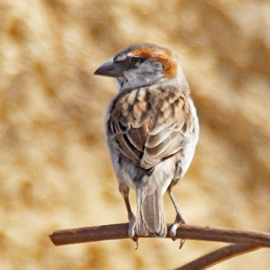 A reduced number of us now continued our journey, and if you are a seabird enthusiast it is probably worth continuing to the Cape Verdes, although
probably only two or three new species will be seen. The Band-rumped Storm-petrels which put in sporadic appearences become Cape Verde Storm-petrels,
but this is largely identification by range/time of year. This recent three or four-way split, to me, is still not the full answer, since no work has been done on the birds of
Ascension, why should they not be a different species also, and what about birds breeding further south?
Predictably, the lack of birds on the open sea continues, although crossing the
equator adds some interest, especially if you've done it before and can therefore opt out of the ceremony to appease Neptune if you wish.
We unfortunately arrived at the main island before dawn, this upset the seabirders since only very distant views of the two main target species were
obtained. However, the captain agreed to sail to the next island and back, this did the trick, as we passed close to large flocks of Cape Verde
Shearwaters and had good views of several Fea's Petrels (Now Cape Verde Petrels according to the latest taxonomy- I DO update the site!)
Audubon's Shearwaters of the race boydi were seen, if using different taxonomy these may be Little or Macronesian Shearwaters.
A few Great Frigatebirds nest on the island, but we weren't lucky with those.
A land trip was also organised, you will not see all the endemics without staying on, but we were happy with Cape Verde Warbler (one of those
large island Acrocephala), Cape Verde Swift, and Iago Sparrow. Endemic races of Grey-headed Kingfisher, Blackcap and Kestrel were seen, but
the critically endangered Purple Heron bournei, which may be a full species, we missed as we got lost and couldn't find the nest tree.
Some consolation came in the form of Cream-coloured Courser, which is also an endemic race, and Brown-necked Raven,
on the way back to the ship, thence to collect our luggage and have a last meal before
making for the airport. The Cape Verdes are now becoming a more popular tourist destination, but unfortunately not all the endemics are easy to see, in particular Raso Lark,
since this requires a visit to the islet of Raso and would probably require a permit, quite apart from a boat to get you there. Another time perhaps?
A reduced number of us now continued our journey, and if you are a seabird enthusiast it is probably worth continuing to the Cape Verdes, although
probably only two or three new species will be seen. The Band-rumped Storm-petrels which put in sporadic appearences become Cape Verde Storm-petrels,
but this is largely identification by range/time of year. This recent three or four-way split, to me, is still not the full answer, since no work has been done on the birds of
Ascension, why should they not be a different species also, and what about birds breeding further south?
Predictably, the lack of birds on the open sea continues, although crossing the
equator adds some interest, especially if you've done it before and can therefore opt out of the ceremony to appease Neptune if you wish.
We unfortunately arrived at the main island before dawn, this upset the seabirders since only very distant views of the two main target species were
obtained. However, the captain agreed to sail to the next island and back, this did the trick, as we passed close to large flocks of Cape Verde
Shearwaters and had good views of several Fea's Petrels (Now Cape Verde Petrels according to the latest taxonomy- I DO update the site!)
Audubon's Shearwaters of the race boydi were seen, if using different taxonomy these may be Little or Macronesian Shearwaters.
A few Great Frigatebirds nest on the island, but we weren't lucky with those.
A land trip was also organised, you will not see all the endemics without staying on, but we were happy with Cape Verde Warbler (one of those
large island Acrocephala), Cape Verde Swift, and Iago Sparrow. Endemic races of Grey-headed Kingfisher, Blackcap and Kestrel were seen, but
the critically endangered Purple Heron bournei, which may be a full species, we missed as we got lost and couldn't find the nest tree.
Some consolation came in the form of Cream-coloured Courser, which is also an endemic race, and Brown-necked Raven,
on the way back to the ship, thence to collect our luggage and have a last meal before
making for the airport. The Cape Verdes are now becoming a more popular tourist destination, but unfortunately not all the endemics are easy to see, in particular Raso Lark,
since this requires a visit to the islet of Raso and would probably require a permit, quite apart from a boat to get you there. Another time perhaps?









